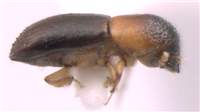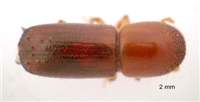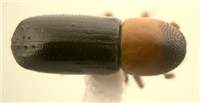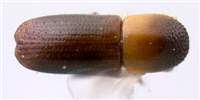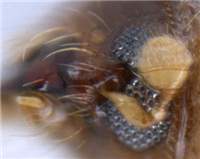Diagnosis
Mostly minute, elongated, with bi-colored pronotum. Elytral declivity flattened and sligtly broadened.
Similar to Xyleborus, but declivity flat and broad, prosternal posterocoxal process not inflated, antennal club type 3..
Distribution
Probably confined to South Asia and Autralasia.
Biology
Mostly in large trees. Size significantly increases with altitude.
Taxonomy
Broadened declivital margin of Planiculus led Wood (1989) and Wood & Bright (1992) to include many species in Euwallacea. Euwallacea spp. are unrelated , usually very large and robust species. Planiculus described by Hulcr & Cognato (2010).
Detailed description
Eyes shallowly emarginate, upper part smaller than lower part. Antennal club approximately circular, type two (obliquely truncated, segment 2 visible on posterior side), or three (segment 1 straight or convex). Segment 1 of club covering most of posterior face, its margin fully costate, straight (may be slightly concave or convex). Segment 2 narrow, pubescent, visible on anterior side only, or visible on both sides of club, if corneous then on anterior side only. Segment 3 absent from or partly visible on posterior side of club. Segment 1 of antennal funicle shorter than pedicel, funicle 4-segmented, scapus thicker and shorter than in most other genera. In some species, mandibular mycangia visible as swellings on epistoma. Frons above epistoma mostly smooth, alutaceous, with minor punctures. Submentum slightly impressed, shaped as very narrow triangle. Anterior edge of pronotum with no conspicuous row of serrations (serrations no different than on pronotal slope). Pronotum from lateral view elongated, with low summit (type 7), often with disc distinctly elongated (type 8). From dorsal view elongated basic shape with rounded frontal margin (type 7), or long, rounded anteriad (type 9). Pronotal disc shining or smoothly alutaceous, with small punctures, lateral edge of pronotum obliquely costate or concave (if pronotum very long). Procoxae contiguous, prosternal posterocoxal process conical and slightly inflated. Tuft on pronotal basis associated with mesonotal mycangium absent, setae on elytral bases associated with elytral mycangium absent. Scutellum flat, flush with elytra. Elytral bases straight, with oblique edge, elytral disc longer than declivity, flat or slightly convex, punctures on elytral disc in strial lines. Boundary between elytral disc and declivity distinct in some species, but mostly indistinct with end of disc rounded, smoothly transitioning into declivity. Lateral profile of elytral declivity usually gradually descending, often flat, dorsal profile of elytral apex broadened laterally, sometimes narrowly emarginate. Elytral declivity with few setae or scales, not conspicuously pubescent. Posterolateral declivital costa ending in 7th interstriae. Inner part of declivity has no tubercles, or only uniform granules, or several tubercles on interstriae 1, 3 and beyond while no tubercles on interstria 2. Striae and interstriae on upper part of declivity flat, not forming ridges and furrows. First interstriae sometimes parallel, but in most species broadened at elytral apex, slightly inflated, bearing several tubercles. Protibiae distinctly triangular, slender on upper part, broad and denticulate on lower part. Posterior side of protibia flat, no granules, only setae. Protibial denticles small, bases of denticles slightly elevated, usually 6 denticles present. Metatibiae of normal size. Color uniformly light brown or reddish, rarely dark brown, pronotum almost always much lighter (yellow or orange) than elytra. Mostly small to minute species, 1.4-2.5 mm, rarely up to 3.2 mm in montane species.

